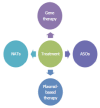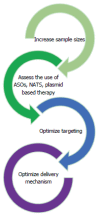High throughput RNA sequencing utility for diagnosis and prognosis in colon diseases
- PMID: 28522900
- PMCID: PMC5413777
- DOI: 10.3748/wjg.v23.i16.2819
High throughput RNA sequencing utility for diagnosis and prognosis in colon diseases
Abstract
RNA sequencing is the use of high throughput next generation sequencing technology to survey, characterize, and quantify the transcriptome of a genome. RNA sequencing has been used to analyze the pathogenesis of several malignancies such melanoma, lung cancer, and colorectal cancer. RNA sequencing can identify differential expression of genes (DEG's), mutated genes, fusion genes, and gene isoforms in disease states. RNA sequencing has been used in the investigation of several colorectal diseases such as colorectal cancer, inflammatory bowel disease (ulcerative colitis and Crohn's disease), and irritable bowel syndrome.
Keywords: Colon; Colon cancer; High throughput; Next generation sequencing; RNA sequencing; Transcriptome.
Conflict of interest statement
Conflict-of-interest statement: The authors have no conflicts of interest or financial disclosures.
Figures



Similar articles
-
Multigene analysis can discriminate between ulcerative colitis, Crohn's disease, and irritable bowel syndrome.Gastroenterology. 2008 Jun;134(7):1869-81; quiz 2153-4. doi: 10.1053/j.gastro.2008.02.083. Epub 2008 Mar 2. Gastroenterology. 2008. PMID: 18466904
-
Neither hide nor hair: the difficulty of identifying useful disease biomarkers.Gastroenterology. 2008 Jun;134(7):2164-8. doi: 10.1053/j.gastro.2008.04.013. Epub 2008 May 16. Gastroenterology. 2008. PMID: 18486617 No abstract available.
-
Whole-Exome Sequencing Analyses of Inflammatory Bowel Disease-Associated Colorectal Cancers.Gastroenterology. 2016 Apr;150(4):931-43. doi: 10.1053/j.gastro.2015.12.036. Epub 2016 Jan 5. Gastroenterology. 2016. PMID: 26764183 Free PMC article.
-
Genetics of inflammatory bowel disease from multifactorial to monogenic forms.World J Gastroenterol. 2015 Nov 21;21(43):12296-310. doi: 10.3748/wjg.v21.i43.12296. World J Gastroenterol. 2015. PMID: 26604638 Free PMC article. Review.
-
Genomic and molecular alterations in human inflammatory bowel disease-associated colorectal cancer.United European Gastroenterol J. 2020 Jul;8(6):675-684. doi: 10.1177/2050640620919254. Epub 2020 Apr 8. United European Gastroenterol J. 2020. PMID: 32268844 Free PMC article. Review.
Cited by
-
RNA expression profiling from the liquid fraction of synovial fluid in knee joint osteoarthritis patients.Am J Transl Res. 2022 Sep 15;14(9):6782-6791. eCollection 2022. Am J Transl Res. 2022. PMID: 36247259 Free PMC article.
-
Microbial and human transcriptome in vaginal fluid at midgestation: Association with spontaneous preterm delivery.Clin Transl Med. 2022 Sep;12(9):e1023. doi: 10.1002/ctm2.1023. Clin Transl Med. 2022. PMID: 36103557 Free PMC article.
-
Extracellular matrix-based gene signature for predicting prognosis in colon cancer and immune microenvironment.Transl Cancer Res. 2023 Feb 28;12(2):321-339. doi: 10.21037/tcr-22-2036. Epub 2023 Feb 15. Transl Cancer Res. 2023. PMID: 36915600 Free PMC article.
-
A pseudo-value regression approach for differential network analysis of co-expression data.BMC Bioinformatics. 2023 Jan 9;24(1):8. doi: 10.1186/s12859-022-05123-w. BMC Bioinformatics. 2023. PMID: 36624383 Free PMC article.
-
Construction of a New Ferroptosis-related Prognosis Model for Survival Prediction in Colorectal Cancer.Curr Med Chem. 2025;32(20):4132-4146. doi: 10.2174/0109298673296767240116215814. Curr Med Chem. 2025. PMID: 38362684
References
-
- Beane J, Vick J, Schembri F, Anderlind C, Gower A, Campbell J, Luo L, Zhang XH, Xiao J, Alekseyev YO, et al. Characterizing the impact of smoking and lung cancer on the airway transcriptome using RNA-Seq. Cancer Prev Res (Phila) 2011;4:803–817. doi: 10.1158/1940-6207.CAPR-11-0212. - DOI - PMC - PubMed
-
- Nalpas NC, Magee DA, Conlon KM, Browne JA, Healy C, McLoughlin KE, Rue-Albrecht K, McGettigan PA, Killick KE, Gormley E, et al. RNA sequencing provides exquisite insight into the manipulation of the alveolar macrophage by tubercle bacilli. Sci Rep. 2015;5:13629. doi: 10.1038/srep13629. - DOI - PMC - PubMed
Publication types
MeSH terms
Substances
LinkOut - more resources
Full Text Sources
Other Literature Sources
Medical

